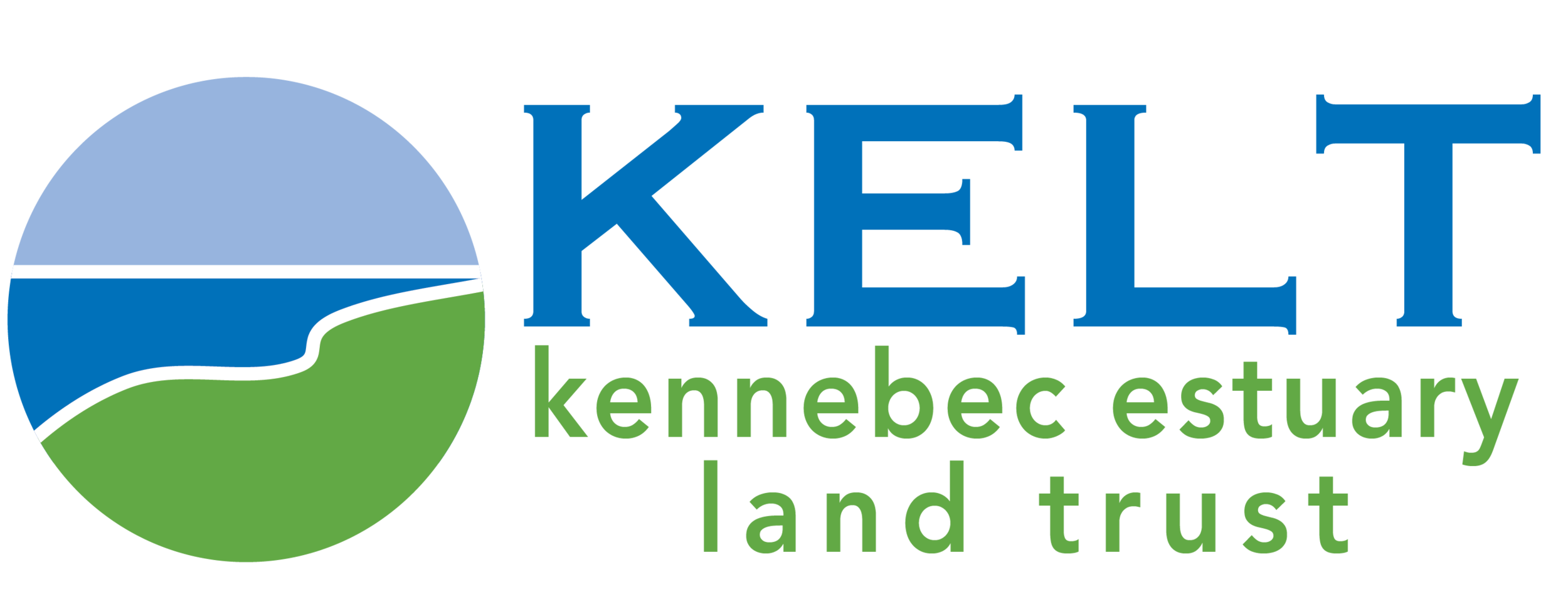Merrymeeting Fields Preserve
No pets allowed
In 2003, the 125-acre preserve was donated to the Trust at the generous bequest of Eleanor B. Burke, long time resident of the property. Mrs. Burke’s will instructed the Trust “to maintain the property’s open space, forests, woodlands, and varied habitats with no hunting, trapping or motor vehicles to be allowed.”
The land is primarily a mixed forest and includes a former farm field which is maintained by KELT for nesting birds and small mammals. It is a wonderful place for bird watching and cross- country skiing. The Preserve also has extensive frontage on Merrymeeting Bay and Chops Creek, an area designated as critical habitat by the Maine Natural Areas Program.
The Trust has cleared trails along the old lighthouse road and through the forest to an impressive overlook on Merrymeeting Bay. This historic site provides fine views of the Kennebec River and Abagadasset Wetlands, high value habitat for nesting and migrating birds. Striped bass spawning grounds lie off the Preserve shore.
History of Merrymeeting Fields
6000 BC
Native Americans visit the banks of Merrymeeting Bay to harvest shad, sturgeon, and other migrating fish species.
1607
Samuel de Champlain sails up the river to Merrymeeting Bay, initiating the European fur trade with Native Americans.
1604 - 1940
Land on East Chopps Point is farmed. In the early 1600s, Dexter Baker raised horses, cows, and pigs on the land, while selling milk and vegetables. He also put up ice, so the family had no need to go to the town of Bath, except for flour.
1720
Robert Temple runs a garrison on Chopps Point, where he is granted 1000 acres in return for bringing 200 settlers to Cork Cove, Dresden.
1860 - 1936
A public road (the wider section of the North Loop Trail!) leads to the range light tended by the Baker-Temple family, to guide ice boats and steam packets away from the rocks.
1880s
Huge iron rings at the Overlook mark the spot where David Trott and his two sons moored their scow to dredge sand from the river.
1930s
Portable steam-driven lumber mills harvest the old pine trees.
1942
The Baker-Temple family, stewards of the land for four generations, sell to George Reynolds.
1952
Reynolds sells the property to Walter A and Eleanor B Burke, who name their new homestead Merrymeeting East.
2002
Eleanor Burke dies, leaving her beloved property to the land trust. She directs, in her will, to “remove all structures from my Chops Point homesite and restore the area to it’s natural vegetative state.” She also gives instruction “to maintain the property’s open space, forests, woodlands, and varied habitats. No hunting, trapping, or motor vehicles allowed.”
August 2006
Merrymeeting Fields Preserve opening celebrations!
Ecology of Merrymeeting Fields
As you enjoy Merrymeeting Fields’ beautiful waterfront and forest, look for six natural features that support a wide variety of flora and fauna.
Open Fields:
The north slope of the ridge is maintained for nesting birds and small mammals. Once a pasture, fields are increasingly rare in Maine as family farms are being abandoned and sold for development.
Mixed Woods:
Two-thirds of the preserve is a forest dominated by red oak, white pine, hemlock, big toothed aspen, and white ash. Winter wrens, ovenbirds, black-throated green warblers, hairy woodpeckers, and barred owls favor this habitat.
Waterfront:
Bedrock ledge broken by mud beaches illustrates Merrymeeting Bay’s geology. Tidal erosion fells old trees, freeing silt that travels with the current until it settles in mudflats. This creates important substrate for aquatic plants, and becomes the feeding grounds for migrating birds. A forested waterfront prevents runoff that lowers water quality, and one might see minks and raccoons browsing the shoreline.
Merrymeeting Bay:
A four by seven mile inland bay, created by the confluence of six rivers, is an outstanding habitat for black duck, blue-winged teal, Canada geese, and many other species that feed on the mudflats. It’s also prime bald eagle habitat — there are seven active nests on the bay. A perfect striped bass spawning ground lies off Merrymeeting Fields’ shore in the quick-moving river waters. Clean water supports nine anadromous species, which are fish that spawn here but live in the ocean for the other part of their lives.
Forested Wetland:
These habitats are damp enough year-round to support sphagnum moss and amphibians. They serve as a sponge to hold water and slowly release it, which protects water quality.
- Driving Directions -
Take Route 1 North to Route 127 (just across Bath bridge on the left). Take North on 127 to Route 128 and turn left. Follow about 6 miles to Chopps Point Road, turn left. 0.9 miles to parking lot and kiosk on right. View Map.
Share what you see at Merrymeeting Fields!
Use iNaturalist to document the plants and animals you see while wandering through Sewall Woods’ trails. The observations you make will appear below, use the tool to check out what people have already recorded!






